Is the Future Female?
In many ways, 2017 was a historic year for women’s empowerment in the United States. First there was the Women’s March for human rights, and then came movements such as Time’s Up and #MeToo, which began in response to a wave of allegations of sexual abuse against men in power, from Hollywood to the White House. And while these movements have dispelled silence, increased solidarity, and brought forth a call for change, many say there is still much work to be done, and that begins with passing legal protections for women.
More than 80% of Americans don’t know women are not guaranteed equal rights in the U.S. Constitution. A proposed amendment, known as the Equal Rights Amendment (ERA), has sat dormant for almost 100 years.
Here Comes Alice
The woman behind the amendment was Alice Paul, a feminist, suffragist, and political strategist. She was a pioneer for women’s rights and accomplished numerous political achievements for women in the 20th century.
Not only did Paul work tirelessly for the Equal Rights Amendment in the States, but also she began the World Woman’s Party (WWP), which worked closely with the League of Nations for gender equality in the United Nations Charter and for the establishment of the United Nations Commission on the Status of Women. Paul also fought for the addition of a sexual discrimination clause to Title VII of the 1964 Civil Rights Act.
In 1923, she created the “Lucretia Mott Amendment” which read, “Men and women shall have equal rights throughout the United States and every place subject to its jurisdiction.” The amendment was introduced in every session of Congress from 1923 to 1972 and in 1943 was rewritten and renamed the “Alice Paul Amendment.” The amendment stated, “Equality of Rights under the law shall not be denied or abridged by the United States or by any state on account of sex.”
The ERA Revival
During the re-emergence of the women’s movement in the late sixties, the ERA came back into play. In 1972, the Senate and the House of Representatives passed the amendment and it went to the states for ratification. Congress gave the amendment seven years for the ratification process and needed 38 states to become a law. Though the deadline was extended until 1982, the amendment fell short of ratification by three states.
Since 1982, the ERA has come before every session of Congress and current efforts are underway to ratify the amendment. In order for the amendment to pass, Congress would need to repeal the time limit of the original bill and three more states would have to vote for ratification.
CEDAW and the United States
The Convention on the Elimination of Discrimination against Women or “CEDAW” as it is widely known was adopted by the United Nations in 1979.
The most important treaty for women’s rights since the Universal Declaration of Human Rights (1948) establishes specific guarantees for women and girls, and of the 193 member states of the United Nations, only seven haven’t ratified the treaty. These include Iran, Palau, Somalia, South Sudan, Sudan, Tonga, and the United States.
In order for the United States to ratify this treaty, two-thirds of the Senate must vote in favor of it; but CEDAW has never made it to the Senate floor for a vote.
The Equal Rights Amendment in HeinOnline
HeinOnline’s U.S. Congressional Documents features the complete Congressional Record Bound version, as well as the daily version back to 1980. It also includes the three predecessor titles: Annals of Congress (1789-1824), Register of Debates (1824-1837), and the Congressional Globe (1833-1873). The database also has more than 60,000 Congressional Hearings (1927-present), as well as other important congressional materials.
Search for Equal Rights Amendment in this database to find hearings and other documents related to this topic. To view only hearings on this amendment, use Refine Your Search and select Congressional Hearings under Document Type.
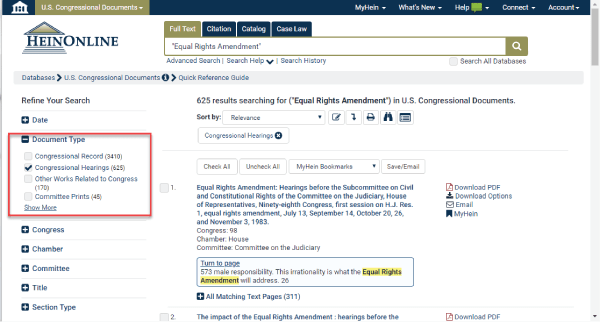
Women and the Law in HeinOnline
In March 2014, HeinOnline released Women and the Law, a collection of books, biographies, and periodicals dedicated to the role of women in society and the law. This collection provides a convenient platform for users to research the progression of women’s roles and rights in society over the past 200 years.
Search for gender inequality in HeinOnline’s Women and the Law collection and receive these results, which include the title Equality before the Law: Justice for Women, available exclusively in this collection.
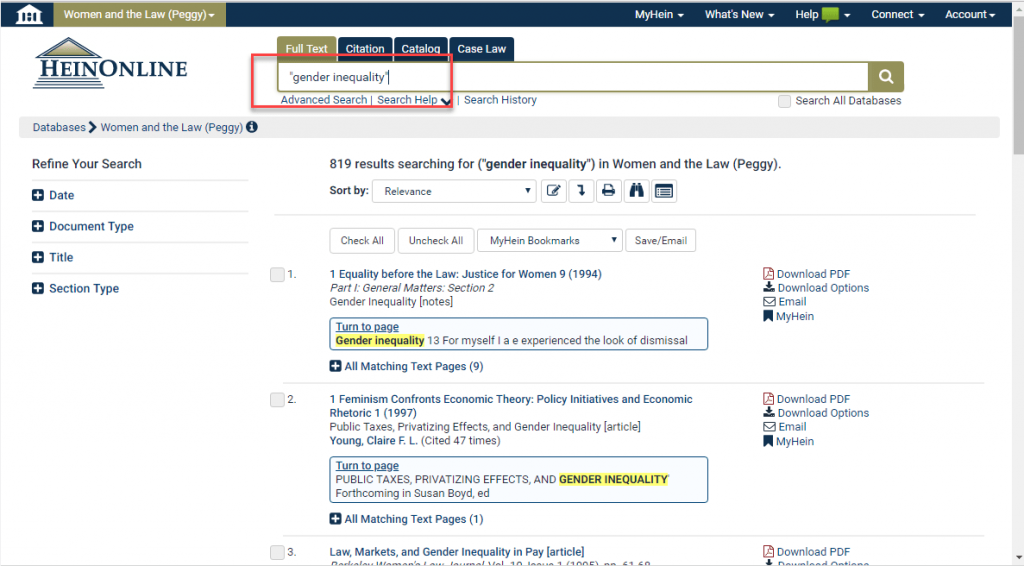
To learn more about the history of CEDAW and the United States, search “United States CEDAW”~10. This will search for the term CEDAW and the words United and States within 10 words of each other. For help with search syntax in HeinOnline, select the Search Help dropdown under the stationary search bar.
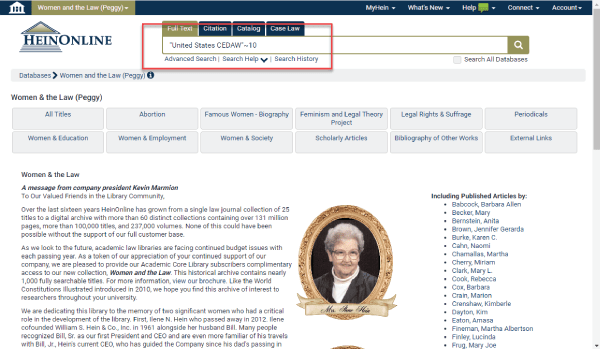
From the results, use Refine Your Search and the Date field and enter 2016 to 2018. This will pull up the most recent results on the topic.
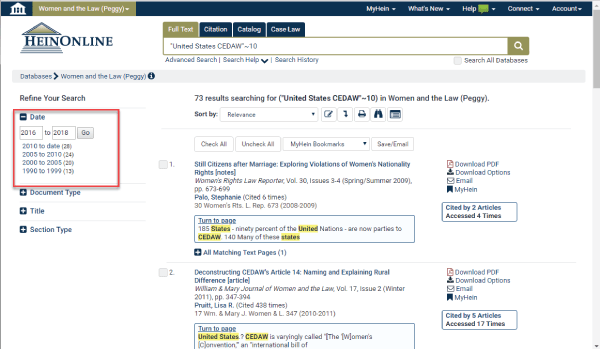
To view titles on Legal Rights & Suffrage for women, navigate to the Legal Rights & Suffrage subcollection at the top of the database homepage.
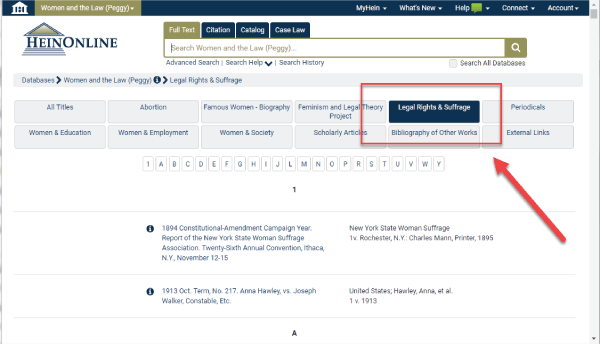
This subcollection includes titles such as Explosive Quarter-Century: A Guide to Monographic Works on Women’s Legal and Political Rights (2003).
Other notable works available exclusively in Women and the Lawinclude:
- History of Woman Suffrage by Susan B. Anthony, Elizabeth Cady Stanton, and Matilda Joslyn Gage, leaders of the National Woman Suffrage Association
- Feminism and Legal Theory Project, which includes workbooks and papers from each FLT conference, as well as newsletters, brochures, and flyers
- Life and Work of Susan B. Anthony: Including Public Addresses, Her Own Letters and Many from Her Contemporaries during Fifty Years
- Law, Ethics and Reproductive Choice by Marcia M. Boumil
For help navigating and searching in HeinOnline or to learn more about Women and the Law, contact the dedicated HeinOnline support team at (800) 277-6995, via e-mail, or chat with us!



